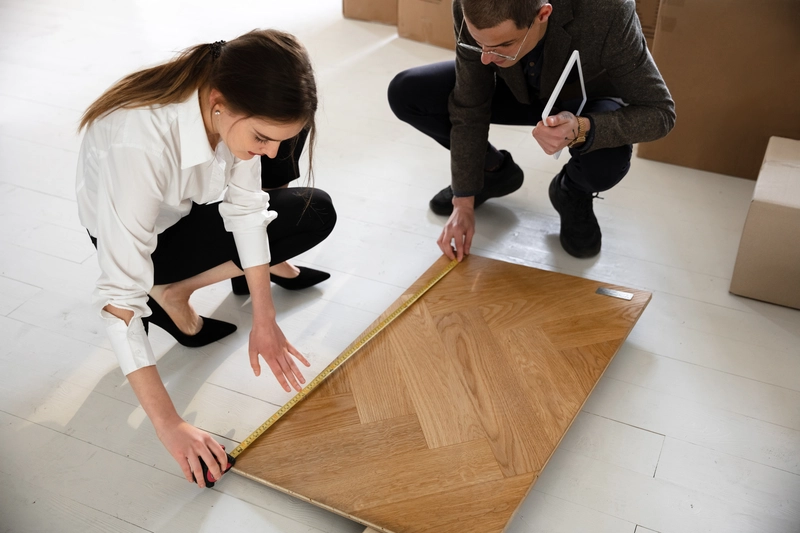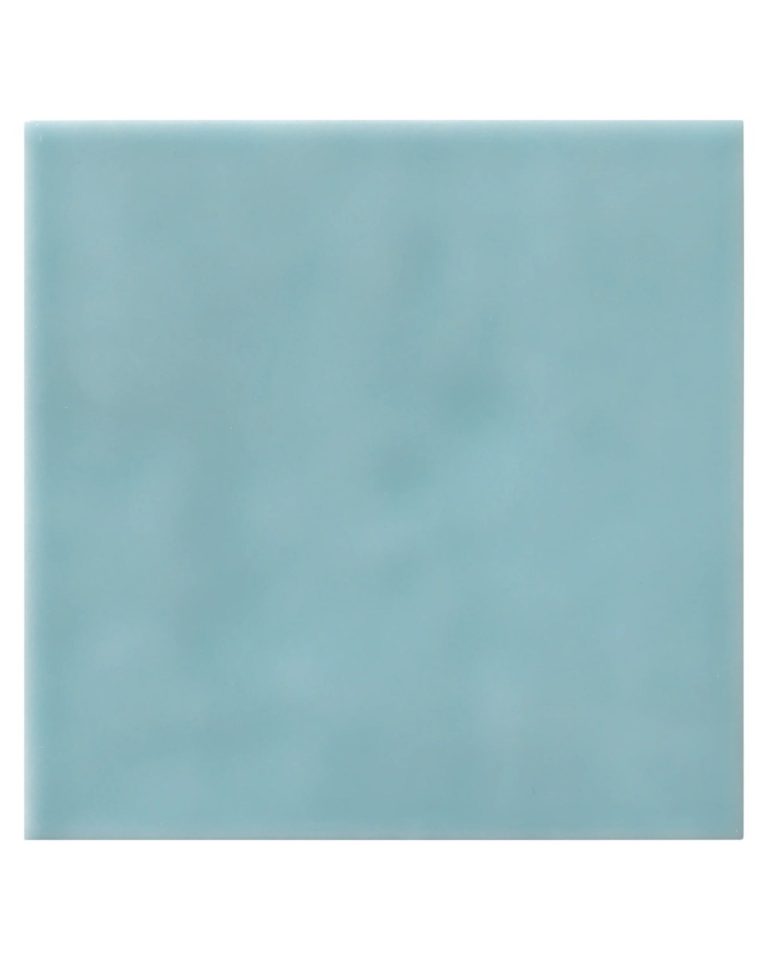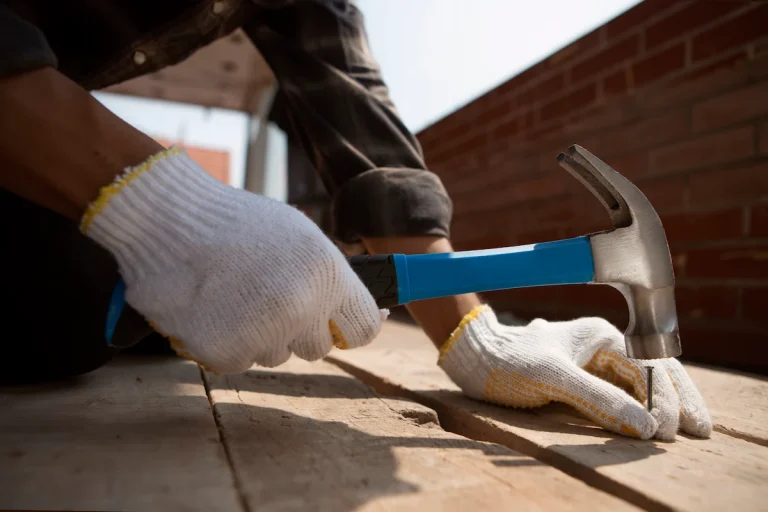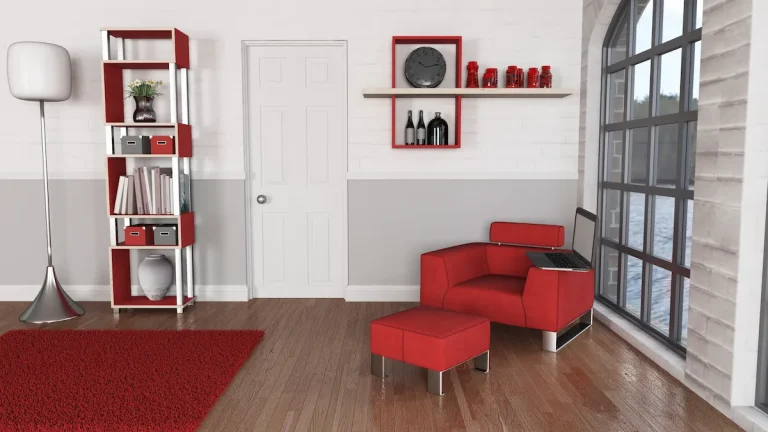Do you need an expansion gap for laminate flooring? One critical aspect often overlooked when installing laminate flooring is the expansion gap, which is crucial in flooring installation. This gap is essential as it enables the flooring to expand and contract in response to fluctuations in temperature and humidity, thereby preventing potential damage over time.
Recognising the significance of the expansion gap, understanding the required space, and being aware of the consequences of neglecting it can help avert costly repairs and ensure proper flooring installation. This guide provides comprehensive information regarding expansion gaps for laminate flooring, ensuring that your installation is both aesthetically pleasing and durable.
What Is an Expansion Gap?
An expansion gap is a crucial feature in flooring installation, particularly for laminate flooring and floating floors, as it allows for the natural expansion and contraction of wooden planks due to temperature changes and varying humidity levels. This gap helps in maintaining repairable floors.
This gap is necessary for maintaining floor stability and preventing potential damage to the flooring system, such as buckling or warping, which can arise when planks are constrained by vertical obstructions such as walls, cupboards, and pipes. Proper use of spacers can ensure the correct gap is maintained. Understanding the concept of an expansion gap is essential for achieving a durable and visually appealing flooring project.
Do You Need an Expansion Gap Important for Laminate Flooring?
The importance of an expansion gap for laminate flooring cannot be overstated, as it plays a vital role in ensuring floor stability and preventing issues such as buckling floors.
When properly integrated during flooring installation, an expansion gap accommodates the natural movement of laminate flooring due to changes in temperature and humidity levels, which can cause planks to expand and contract.
By including an adequate and proper expansion gap, homeowners can avoid costly repairs, maintain the aesthetics of their laminate flooring, and ensure that planks can expand and contract naturally.
How Much Expansion Gap Do You Need for Laminate Flooring?
Determining the appropriate laminate flooring expansion gap is essential to ensure its long-term durability and performance, and this often depends on various factors including the manufacturer’s recommendations, room size, and shape, as well as climate and humidity levels. Manufacturer instructions often provide the specific details required.
Each laminate flooring product may have specific guidelines on the size of the expansion gap required, which is crucial for the successful installation of floating floors. Additionally, understanding how room dimensions and environmental conditions interact with the flooring can help in calculating the optimal expansion gap needed.
a. Manufacturer’s Recommendations
Manufacturer recommendations for the expansion gap in laminate flooring often provide the best guideline for ensuring a successful installation and long-lasting durability. Each laminate flooring product may have specific requirements based on its design and composition, and adhering to these guidelines is crucial to avoid issues such as buckling or uneven surfaces.
Understanding the intricacies of these specifications is vital for any homeowner or installer. For instance, the recommended gap can vary significantly depending on the product brand and the environment in which it is installed. Ignoring these recommendations can lead to serious consequences:
- Increased risk of structural damage, such as warping or cracking, due to expansion and contraction with temperature changes, causing planks to expand or contract.
- Uneven surfaces not only look unappealing but can also be hazardous.
- Voided warranties if the installation does not comply with the manufacturer’s guidelines.
Therefore, paying close attention to these details can help ensure the longevity and performance of laminate flooring.
b. Room Size and Shape
The size and shape of the room play a significant role in determining the necessary expansion gap for laminate flooring, as larger areas typically require wider gaps to accommodate expansion. Irregularly shaped rooms may necessitate different gap sizes in various locations to ensure the flooring remains stable and doesn’t buckle or warp. Proper planning is key in managing these variations.
When considering installation, one should first measure the room’s dimensions accurately. Use a measuring tape to determine both the length and width, taking note of any alcoves or protrusions that can alter the layout.
- For rectangular spaces, adhering to the recommended 6mm gap around the perimeter is generally sufficient.
- Conversely, in an L-shaped room, multiple gaps might be necessary where the two sections meet, potentially increasing to 12mm in tighter spaces.
It’s wise to account for temperature variations, as temperature fluctuations can cause the laminate to expand or contract. Planning for these scenarios aids in achieving a successful and lasting installation.
c. Climate and Humidity Levels
Climate and humidity levels significantly influence the expansion gap required for laminate flooring, as different environmental conditions can cause wooden planks to expand or contract more noticeably. In regions with high humidity, for instance, a larger expansion gap may be necessary to prevent the flooring from buckling or developing seams.
Understanding how these factors interact can help homeowners make informed decisions when installing laminate floors. In high-humidity regions, the moisture in the air can lead to significant expansion of the planks, making it essential to create larger gaps in the installation. Conversely, in arid climates, where the air is less humid, the expansion gaps can be smaller, as the flooring may contract more than expand. Using spacers during laminate installation can help maintain the correct gap.
- Assess local humidity levels regularly using a hygrometer.
- Consider adjusting the installation practices to account for these variations.
- Utilise moisture-resistant underlay in particularly damp areas.
It’s advisable to seal the home’s windows and doors to minimise fluctuations in indoor humidity, ensuring that the flooring system remains stable over time.
What Happens If You Don’t Leave an Expansion Gap for Laminate Flooring?
Failing to leave an expansion gap during laminate flooring installation can lead to significant problems, including buckling, gaps, and separations between the boards.
Without this crucial allowance for movement, the laminate flooring may not have the freedom to expand and contract with temperature changes and humidity levels, resulting in an uneven surface and ultimately leading to major inconveniences and expensive repairs.
a. Buckling and Warping
Buckling and warping are common issues that arise when an expansion gap is not provided in laminate flooring installations, leading to a distorted appearance and compromised structural integrity. These problems occur when temperature changes and humidity levels cause the wooden planks to expand without any space to accommodate their movement.
As laminate flooring absorbs moisture from the air, it can swell and create visible bulges or gaps. This physical manifestation can alter the flooring’s aesthetic appeal, creating unsightly waves or lifts that detract from the room’s overall elegance.
Warping often occurs due to excessive moisture exposure, resulting in planks that no longer lie flat and disrupt the seamless flow of the floor. To mitigate these concerns, it is essential to implement a few preventative measures:
- Ensure proper acclimatization of the flooring material before installation. Follow manufacturer instructions carefully during this process.
- Maintain a consistent indoor climate by using dehumidifiers or air conditioning units.
- Leave adequate expansion gaps along walls and fixtures to allow for wood movement.
In addition, if buckling or warping does occur, promptly addressing the issue can prevent further damage. This may involve removing affected sections and replacing them once humidity levels stabilise.
Regular maintenance checks can also enhance the longevity and beauty of laminate flooring, ensuring it remains a stunning feature in any home. Ensuring that the molding coverage is intact can also prevent the entry of debris.
b. Gaps and Separations
When an expansion gap is ignored, gaps and separations can develop between the planks of laminate flooring, resulting in an unappealing and uneven surface. These separations can compromise the functional aspects of the flooring, making it more susceptible to damage and wear over time, and ultimately detracting from the overall aesthetic of the space.
In many cases, the absence of a proper expansion gap leads to significant warping or buckling of the flooring, which can exacerbate the existing issues. Not only does this create a less inviting atmosphere, but it also presents a challenge when trying to maintain the integrity of the flooring as moisture and humidity fluctuations come into play. It’s crucial to be proactive in monitoring these conditions.
Addressing these concerns is essential for both the longevity and visual appeal of the flooring. Here are some effective tips to remedy separations and ensure the installation remains intact:
- Inspect the flooring regularly to identify any initial separations.
- Consider using a proper levelling compound if uneven surfaces are present.
- Reinstalling with an appropriate expansion gap is crucial for future stability.
- Utilise a humidifier in particularly dry climates to mitigate gaps caused by shrinking.
By remaining proactive in maintenance, owners can enhance the durability and visual harmony of their laminate flooring.
How to Create an Expansion Gap for Laminate Flooring
Creating an expansion gap for laminate flooring involves several key steps, including accurately measuring the room, determining the appropriate gap size, and using spacers during installation, as the planks expand and contract over time.
Properly executed, these steps will ensure the longevity and stability of your laminate flooring, preventing issues such as buckling and separations, especially as the planks expand and contract.
1. Measure the Room and Determine the Needed Gap Size
Measuring the room accurately and determining the appropriate gap size are critical steps in creating an expansion gap for laminate flooring, as these choices directly influence the flooring’s performance and stability.
Start by measuring the total area of the room and accounting for any vertical obstructions, like cabinets or moulding, that may affect the gap. To effectively navigate this process, the first step is to gather essential tools, such as a measuring tape and a notepad for recording dimensions. When measuring, one should:
- Take precise measurements of the room’s length and width, ensuring to note any irregularities or alcoves.
- Subtract the dimensions of any vertical obstructions, like columns or built-ins, to avoid miscalculation.
- Consider the laminate flooring specifications, which usually recommend a gap of 6 mm to 12 mm to accommodate expansion.
The presence of vertical obstructions can significantly impact the gap size; thus, it’s essential to assess their location and height carefully. This attention to detail will ultimately contribute to the longevity and durability of the floors, ensuring that the finished product remains aesthetically pleasing and functional over time.
Adhering to these guidelines will create an environment conducive to optimal performance and user satisfaction.
2. Use Spacers or Shims
Using spacers or shims is essential for maintaining the desired expansion gap during laminate flooring installation, ensuring that the gap remains consistent around the perimeter of the room. These tools help to create a uniform distance between the laminate planks and vertical obstructions, such as walls and cabinets, which is crucial for accommodating any expansion or contraction due to temperature fluctuations and humidity changes.
Different types of spacers are available, each designed to suit specific flooring needs. Proper placement is vital to achieve optimal results. For instance, using thicker spacers may be necessary for wider planks to ensure an appropriate expansion gap.
Here are some key points to consider:
- Material type: Choose spacers made from durable materials that won’t compress over time.
- Size considerations: The size of the spacer should be selected based on the specifications of the laminate flooring.
- Installation tips: Position the spacers at regular intervals and check for alignment while laying the panels, ensuring the spacers use is optimal.
By selecting the right spacers and placing them correctly, one can guarantee a reliable and consistent expansion gap, preventing issues in the future.
3. Trim the Flooring to Fit the Gap
Trimming the flooring to fit the expansion gap is an important final step in the installation process of laminate flooring, ensuring that the flooring adheres properly while also allowing for necessary movement. This step involves carefully cutting the laminate boards to create a seamless fit around the designated gaps without compromising their stability.
Properly addressing the expansion gap requires precision and attention to detail. Utilising the right tools is crucial for achieving clean cuts; a jigsaw or circular saw works effectively for this purpose.
Before beginning the trimming process, measure each gap accurately to ensure a consistent distance throughout the area.
- Mark your measurements clearly on the laminate boards.
- Secure the boards to prevent any movement while cutting.
It’s wise to wear safety gear, including goggles and gloves, to protect yourself during the cutting process. Remember, maintaining even gaps not only enhances the aesthetic appeal but also facilitates the functional expansion of your laminate flooring, helping it withstand seasonal changes.
The Alternatives to an Expansion Gap for Laminate Flooring
While the expansion gap is a fundamental requirement in standard laminate flooring installations, there are alternatives such as floating installation, glued-down installation, and nailed-down installation that may mitigate the need for traditional expansion gaps.
Each of these methods offers unique benefits and considerations depending on the project and environmental factors.
1. Floating Installation
Floating installation is a popular method for laminate flooring that minimises the need for an expansion gap, as the flooring floats above the subfloor and accommodates movement naturally.
This technique allows for easier installation and reduces the likelihood of buckling due to environmental changes.
By utilising interlocking planks, this technique enables a streamlined process that can often be completed in a fraction of the time required for traditional installation methods, which typically involve gluing or nailing down materials.
Because of its adaptability, floating installation is especially advantageous in areas prone to temperature fluctuations, such as basements or sunrooms, where variations in humidity and heat can present challenges.
This method can provide an improved sound barrier and cushion, making it a sound choice not only from an aesthetic standpoint but also in terms of comfort, compared to a traditional hardwood floor.
- Ease of installation
- Reduction in stress on flooring
- Improved acoustics
These aspects make it an appealing option for do-it-yourselfers as well as professional installers. As a versatile solution, floating installation holds its ground as a viable alternative to more rigid, traditional flooring methods.
2. Glue-Down Installation
Glue-down installation is an alternative approach for laminate flooring that often eliminates the need for an expansion gap, as the adhesive secures the planks directly to the subfloor. This method is effective in minimising movement and offers a more solid feel underfoot.
This installation technique is particularly advantageous in environments with fluctuating temperatures, where floating installations might face issues such as buckling. By bonding the flooring in place, glue-down installations provide enhanced stability and durability, making them suitable for high-traffic areas like entrances and corridors.
- One of the primary benefits is the reduction of noise, resulting in a quieter living space.
- Potential drawbacks include the difficulties of plank removal later on, as the strong adhesive binds the material to the floor.
- The curing time for the adhesive must be considered, as it may delay project completion.
In instances where moisture is a concern, glue-down installation can be further enhanced by using moisture-resistant adhesives, making it a secure choice for basements or kitchen applications.
3. Nail-Down Installation
Nail-down installation is another alternative to traditional expansion gap requirements in laminate flooring, securing planks directly to the subfloor while allowing for minimal movement. This method is often employed in specific applications where added stability is desired.
This technique involves fixing each plank to the subfloor using nails or staples, providing a robust and secure foundation. Unlike floating or glue-down methods, which allow for more flexibility, nail-down installation promotes greater durability and resistance to shifting, making it ideal for high-traffic areas or regions subject to temperature fluctuations.
- In terms of benefits, this method offers enhanced stability, reduced sound transmission, and minimizes the risk of damage due to warping.
- The technique does require a solid and level subfloor as it cannot easily accommodate imperfections.
- It may not be suitable for DIY enthusiasts without the right tools or expertise.
While nail-down installation presents some limitations, its advantages can outweigh them when installed in optimal conditions.
So, if you’re ready to install laminate flooring, don’t skip the expansion gap—and trust TEKA Flooring to get it right. With our expert installation services, your new floor will look stunning and perform flawlessly for years to come!
Read also:

































